Urban Markets
Posted on November 3, 2015 by bob in Travel
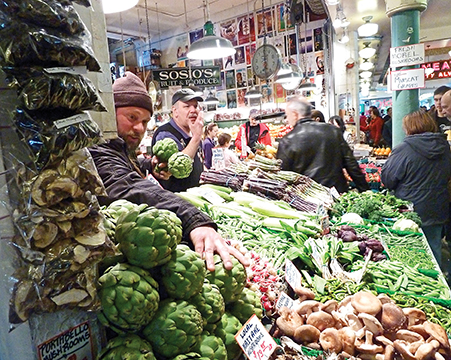
Veggie stand at Pike Market, Seattle.
by Andrea Gross; photos by Irv Green
I expect Seattle’s Pike Market to be colorful, crowded and caffeinated, as befits the city that birthed Starbucks, but I don’t expect flying salmon. Yet here are men in white aprons flipping giant fish with the ease that most folks flip pancakes. One of the fishmongers grins as a salmon slips onto the counter and somersaults into a bin. “Want one?” he asks. I decline and walk on to see the flowers, which smell infinitely better.
Like other urban markets, Pike Market reflects its surroundings. Salmon in Seattle? Of course. (Taste them in a market restaurant or have them shipped to your home.) Gator-burgers in New Orleans? (Eat them on the spot.) Clam chowder in Boston? Most definitely. Although in some cities commercial establishments have moved in, the emphasis in urban markets is always on locally sourced food and regionally unique products.
That’s what makes them so much fun for the traveler.
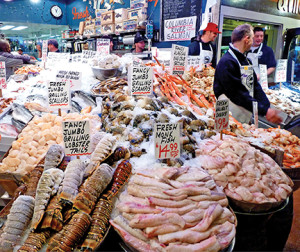 Seattle’s Pike Market: the country’s oldest continuously operating market (www.pikeplacemarket.org)
Seattle’s Pike Market: the country’s oldest continuously operating market (www.pikeplacemarket.org)
My husband and I weave past performers strumming guitars, dodge groups of tourists, and inhale the strong smells of curry, kimchee, coffee and chocolate. Vendors ply us with samples: a handful of dried fruit, a slice of apple, a chunk of cantaloupe and the best chocolate-covered cherry I’ve ever tasted.
No wonder, since Washington is the top sweet cherry producing state in the nation. Washington also grows more onions than any other state, and Pike Market owes its existence to onion-hungry citizens, price-gouging middlemen, and a sympathetic politician.
In response to his constituents, who were furious that the price of onions had risen dramatically, Seattle Councilman Thomas Revelle suggested that farmers set up shop on an empty street corner and sell directly to their customers. In August 1907 eight farmers did just that. Their produce sold out within hours, and the business practices of Seattle were forever changed.
Now, 108 years later, more than 100 farmers and 200 craftsmen and women rent space at the market, which has expanded to cover nine acres.
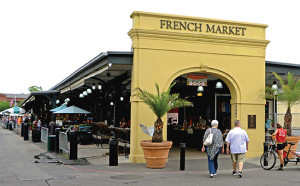 New Orleans’ French Market: America’s oldest public market (www.frenchmarket.org)
New Orleans’ French Market: America’s oldest public market (www.frenchmarket.org)
Seattle’s market may hold the title of the oldest continuously operating market, but New Orleans’ French Market predates it by more than 100 years.
It began as a Native American trading post in 1791 but quickly grew into a multi-ethnic hub as new arrivals flooded the area. Now vendors sell everything from homegrown food to handmade crafts, many of which feature fleur-de-lis in one form or another — on mugs, door knockers, T-shirts and neckties. I’m not into fleur-de-lis décor, and I can easily pass on alligator models and Mardi Gras masks, but I succumb to temptation when I see a handmade  voodoo doll. After all, you never know when a little magic might come in handy.
voodoo doll. After all, you never know when a little magic might come in handy.
The food presents a bigger problem. Do I want gator meat on a stick, in a burger or atop a salad? And then there’s the muffuletta, a deli sandwich favored by Sicilian farmers who were selling their goods at the market. We look at the sandwich, a layered powerhouse consisting of a marinated olive salad, three meats and two cheeses. It’s a tough call. We opt for both.
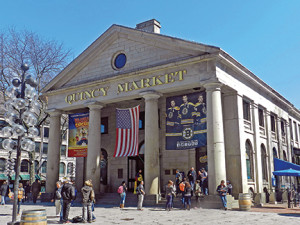 Faneuil Hall Marketplace: the nation’s first Festival Market (www.faneuilhallmarketplace.com)
Faneuil Hall Marketplace: the nation’s first Festival Market (www.faneuilhallmarketplace.com)
Some folks call it Faneuil Hall Marketplace; others call it Quincy Market. Either way, it’s a favorite meeting place for Bostonians and one of the city’s top visitor attractions.
The area was first a public food market, then the site of an historic hall where a reception was held for George Washington. Later, in the nineteenth century, it was the home of one of the largest market complexes in the country. But despite its storied history, by the early 1970s it was simply a group of decaying buildings, and the city wanted to tear them down.
Instead, some concerned citizens turned them into a “festival marketplace,” the first one in the United States. 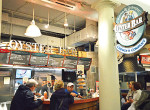 The old Faneuil Hall and Quincy Market became a “festival” of stores, restaurants and pubs, thus revitalizing not only the old buildings but the surrounding area as well.
The old Faneuil Hall and Quincy Market became a “festival” of stores, restaurants and pubs, thus revitalizing not only the old buildings but the surrounding area as well.
We snack and wander — taste-testing clam chowder and baked beans, admiring pewter mugs and trying on T-shirts that celebrate Boston colleges and sports teams.
Our last stop is at Make Way for Ducklings, a bookstore that honors Robert McCloskey’s classic tale of a group of Bostonian mallards. I resist buying my granddaughter a toy mallard imprinted with the word “Boston,” and instead get her a book of Mother Goose rhymes. She may as well learn now that the little pig who went to market had a lot more fun than the ones who stayed home.









